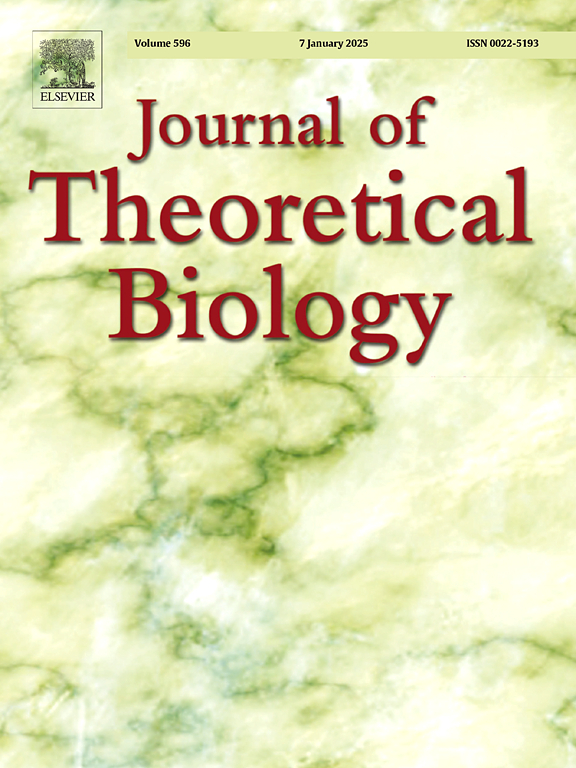细丝周转和成核模型中的涌现微管特性。
IF 2
4区 数学
Q2 BIOLOGY
引用次数: 0
摘要
微管(MTs)是细胞内组织和运输所必需的动态蛋白丝,特别是在神经元等长寿细胞中。神经元MTs的正负两端在生长和萎缩阶段之间切换,新丝的成核被认为在健康和损伤条件下都受到调节。我们提出了随机和确定性的数学模型来研究丝成核和长度调节机制对活细胞中MT长度和数量等紧急特性的影响。我们扩展了长丝动力学的随机连续时间马尔可夫链模型,以纳入MT成核,并捕获MT数和微管蛋白可用性的实际随机波动。我们还提出了一个简化的偏微分方程(PDE)模型,该模型允许对不同成核和长度调节机制下的稳态MT分布进行易于处理的分析研究。我们发现随机和PDE建模方法在MT长度分布上表现出很好的一致性,并且MT成核和大长度MT的突变率都调节MT长度分布。在这两个框架中,多个机制组合实现相同的平均MT长度。所提出的模型可以预测系统缺乏微管蛋白(MT的组成部分)的参数体系,并表明低丝成核体系的特征是MT长度的高变化,而高成核体系驱动MT数的高变化。这些数学框架有可能提高我们对MT在健康和受伤神经元中的调节的理解。本文章由计算机程序翻译,如有差异,请以英文原文为准。
Emergent microtubule properties in a model of filament turnover and nucleation
Microtubules (MTs) are dynamic protein filaments essential for intracellular organization and transport, particularly in long-lived cells such as neurons. The plus and minus ends of neuronal MTs switch between growth and shrinking phases, and the nucleation of new filaments is believed to be regulated in both healthy and injury conditions. We propose stochastic and deterministic mathematical models to investigate the impact of filament nucleation and length-regulation mechanisms on emergent properties such as MT lengths and numbers in living cells. We expand our stochastic continuous-time Markov chain model of filament dynamics to incorporate MT nucleation and capture realistic stochastic fluctuations in MT numbers and tubulin availability. We also propose a simplified partial differential equation (PDE) model, which allows for tractable analytical investigation into steady-state MT distributions under different nucleation and length-regulating mechanisms. We find that the stochastic and PDE modeling approaches show good agreement in MT length distributions, and that both MT nucleation and the catastrophe rate of large-length MTs regulate MT length distributions. In both frameworks, multiple mechanistic combinations achieve the same average MT length. The models proposed can predict parameter regimes where the system is scarce in tubulin, the building block of MTs, and suggest that low filament nucleation regimes are characterized by high variation in MT lengths, while high nucleation regimes drive high variation in MT numbers. These mathematical frameworks have the potential to improve our understanding of MT regulation in both healthy and injured neurons.
求助全文
通过发布文献求助,成功后即可免费获取论文全文。
去求助
来源期刊
CiteScore
4.20
自引率
5.00%
发文量
218
审稿时长
51 days
期刊介绍:
The Journal of Theoretical Biology is the leading forum for theoretical perspectives that give insight into biological processes. It covers a very wide range of topics and is of interest to biologists in many areas of research, including:
• Brain and Neuroscience
• Cancer Growth and Treatment
• Cell Biology
• Developmental Biology
• Ecology
• Evolution
• Immunology,
• Infectious and non-infectious Diseases,
• Mathematical, Computational, Biophysical and Statistical Modeling
• Microbiology, Molecular Biology, and Biochemistry
• Networks and Complex Systems
• Physiology
• Pharmacodynamics
• Animal Behavior and Game Theory
Acceptable papers are those that bear significant importance on the biology per se being presented, and not on the mathematical analysis. Papers that include some data or experimental material bearing on theory will be considered, including those that contain comparative study, statistical data analysis, mathematical proof, computer simulations, experiments, field observations, or even philosophical arguments, which are all methods to support or reject theoretical ideas. However, there should be a concerted effort to make papers intelligible to biologists in the chosen field.

 求助内容:
求助内容: 应助结果提醒方式:
应助结果提醒方式:


